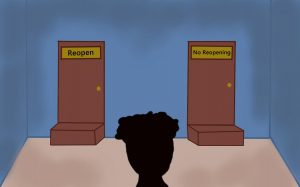Starting a nonprofit to say that you started a nonprofit is selfish — not service
In the pressure to stand out among peers, creating a nonprofit may seem like the best choice in hindsight, but in reality it selfish and does more harm to the community than good.
October 31, 2020
When the recent pandemic hit SRVUSD in early March, the uncertainty of high school students’ futures was put into question. Students demanded answers, and for the most part, there was no definitive answer. With the abundance of time that lockdown brought, it seems like no coincidence that a surge in new “nonprofit organizations” became prevalent as students desperately took the extra time to hop onto the bandwagon of founding an organization.
It’s no secret that starting a non-profit seems to be an unspoken fast-pass to academic clout and success; the title of “Founder of … ” is a flashy addition to any student’s resume. Some high school students have founded non-profits with significant impacts, which resulted in them attending prestigious institutions. However, these organizations were developed over a long period of time and therefore had the ability to grow over the years, and isn’t the sole reason behind the students’ academic success. Nadya Okamoto, co-founder of PERIOD, launched her organization after experiencing homelessness her freshman and sophomore years of high school. She noticed that care packages rarely contained feminine hygiene products. Given the longevity of her nonprofit, PERIOD has now been able to address over 900,000 periods through product distribution for people in need of menstrual products.
However, what some nonprofits do is actually more counterproductive than it is beneficial to the community it aims to support. Many students have been inspired to create nonprofits that focus on mental health, COVID-19, and other global issues in the past months. Though we do recognize the importance of solving these issues, contributing to established and more professional organizations that already exist rather than creating additional organizations would have a greater impact, as they already have the resources and connections necessary to do so.
“A lot of the nonprofits I’ve encountered on social media are just middlemen because they’re diverting actual resources from experts and people whose entire careers are working for others. It’s more counterproductive than helpful,” said Dougherty Valley senior Amritha Ramesh. “If that money was donated to a bigger organization or if people knew exactly how to handle that money or resources, they could distribute it better and impact more people than what is currently being done by smaller school nonprofits.”
The counterproductivity of creating additional organizations is also evident on a national level. 1.8 million nonprofit organizations exist in the US, but fewer than 15% operate on budgets over $250,000. That does not mean smaller organizations do not make any impact, but it rather suggests that it may be more effective to donate to existing organizations, who already struggle because of the competition for limited donations, grants, and resources. Creating more organizations that have the same goal as existing, more established nonprofits is counter-productive.
If a student’s goal is to have a genuine and significant impact on the community they serve, merging with an existing nonprofit may be a more effective way to create this impact rather than starting their own from the bottom-up. For example, many students at SRVUSD have created a variety of podcasts on similar issues, or organizations that collect hand-made masks in order to distribute to healthcare workers, again, acting as a middleman.
If students reached out to each other and worked to merge nonprofits with similar goals, it could allow for more connections, expansion, unique ideas, and ultimately, a greater community impact. Given the rise of platforms such as Instagram and Facebook in creating such connections, it is more accessible than ever to create a social media account. Not only are students viewing the continuous promotion of their peers’ new organization, but they are now able to see how easy it is to claim the title of a nonprofit themselves.
“There’s nothing wrong with starting your own organization. But if you decide to use social media as your only source of communication with your audience, you better make sure your efforts are transparent and that you are being genuine with your work. From my point of view, a lot of social media and student-led initiatives will DM you and be like, ‘follow for follow’ or ‘shout-out for shout-out’,” said senior Ellie Yan, co-founder of Project CreateAFuture. “When you see an organization attempting to accumulate recognition and power by numbers solely through social media, that’s a very telling sign that there’s something suspicious about that. If you are genuinely really passionate or authentic about your initiative, you won’t solely be trying to acquire by numbers, but through tangible action.”
Yan’s initiatives are a good example of a student-led organization who has been able to create far-reaching impacts over a longer period of time. She co-founded Project CreateAFuture with fellow senior Sarah Yao their sophomore year in an effort to be more environmentally sustainable. Since their founding, they have donated over $1,000 to Alturas Wildlife Sanctuary, through selling items such as pins, sweatshirts, and tees.
In the end, we are not trying to expose anyone for their efforts, genuine or not. If anything, we applaud anyone interested in starting a nonprofit for their initiative and leadership. But if you are someone who has or has thought of creating a nonprofit (or done anything, really) for the sake of ulterior motives, then what we hope is that you will remember and reflect on the true meaning of community service. We understand the pressure of the environment that you are under, but we hope that you can consider more productive modes of creating change and act merely on your own passions and interests.
Consider the group of people you could be harming as opposed to helping by creating a nonprofit solely for your student profile. In doing so, you are taking advantage of a certain community’s struggles for your own benefit, and that in itself is a selfish act. The point of a nonprofit is to address a certain community and help them. Students are restricting themselves from achieving this goal by quickly creating organizations and prioritizing the title that comes with creating one over improving their community. These extrinsic desires only go so far, as once you graduate from high school, will that motivation to serve this community remain? At the end of the day, it is your intrinsic desire to help and serve the community that will have the most productive outcome, and will be the most long-lasting.






